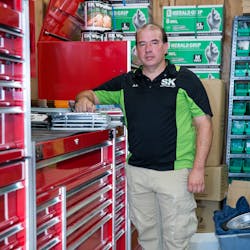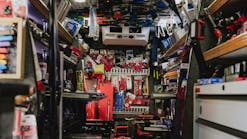With tools on the truck, there are generally two main types of sales. There’s the “I need it now” type of sale and then there’s the impulse, “Oh, I could use that” type of sale. When it comes to selling tool storage from the truck, a customer’s approach is widely different.
By having a higher price tag, technicians often conduct their own research prior to stepping onto the truck.
“It’s almost like buying a car,” says John Peruffo, owner of New York’s Sharpest and SK Professional Tools mobile distributor. “They know the make, model, color, and the price point where they need to be at, and they need you to search out dealerships that can best serve them.”
Peruffo has proven to know a thing or two on selling tool storage despite only being a mobile dealer for the past four years. Now retired from the NYPD and from having a second job as an automotive technician, Peruffo runs his route in and around the five boroughs of New York City.
His latest sale was a Homak 72” roller cabinet with matching 72” top box along with a 43” toolbox top and bottom. The customer, an owner of a local concrete company, purchased the roller cabinet for his business and the toolbox for his home garage. But the sale didn’t end there. Peruffo completed the sale by then filling both boxes with all new tools from his truck.
“It was seamless,” he notes. “It only took me about seven days to get the toolboxes delivered to him from when he put the initial order in. He was up and running in a week.”
When customers approach Peruffo, they usually look around first to get an idea on prices.
“They already look at the bigger franchises to see their price points,” he says. “Their price points are either out of range or they don’t feel it’s necessary to spend $15,000 on a singular modular tool storage unit, so they will come to me with a price point.”
If technicians need help researching their options or narrowing them down, Peruffo will print out flyers to help illustrate their choices and will work with them to determine their needs.
While selling tool storage — whether a toolbox or cart — may not be a weekly sale or even a monthly sale, it’s still vital for mobile tool dealers to keep informed on new releases and features to find the right match for their customers.
Finding the right solution
For technicians, tool storage is more than just a box to store their tools. It keeps their valuable tools protected from the elements and other users. It also helps them stay organized.
“There are so many boxes and service carts out there that you’re looking for what fits [your customer’s] needs,” says Rich Heidelberger, vice president of engineering at Mechanic’s Time Savers.
Having proper tool storage allows technicians to find tools quickly, helping them to get the job done more efficiently, he adds.
“Each storage solution is unique to each users’ wants and needs,” says Destiny Skipper, marketing manager of Beta Tools USA. “Some need a unit that they can collapse and take with them while other users need a fully customized shop with top to bottom cabinets.”
Ultimately, tool storage is not a one-size-fits-all. There are many specs and features to choose from, including mobility, size, construction, and features.
Mobility
From tool carts used to tackle a specific job to an all-around roller cabinet, being able to move from bay to bay or across the shop is gaining popularity.
“Tool carts are a game changer,” Peruffo says, noting that even established technicians who have been in the field for a while and have a stationary box are now jumping over to a tool cart. “They have their main box and [now] a mobile cart for their brake tools, oil change tools, and other things that are common for them to have throughout the day.”
Technicians who are just starting out in the field are also turning to tool carts.
“At least until they outgrow it and then move to a large, stationary toolbox,” Peruffo explains.
Aside from mobility, flexibility is another reason technicians are turning to tool carts.
Beta Tool’s newly released C50S Service Tool Cart with 3 Drawers was designed to offer flexibility and storage on the go. It features three slide-out drawers, ideal for hand tools, and a large open bottom area for more oversized items like small compressors or large parts.
In addition, the C50S also includes a side screwdriver holder, thermoplastic worktop, and built-in spray can holders on each side for easy access and convenience.
Size and construction
Every work area is different and although a technician may want the biggest toolbox, they may not have the space for it.
“Some guys come in and want the bigger box, like a 72” box, and then I go look in their shop and say, ‘You can’t fit that box in here,’” Peruffo laughs. “The box will be in the shop, but no cars will be coming in for repair work.”
For repair shops, space is limited and oftentimes shop owners will only allow their technicians to get a certain size frame. On the other hand, dealerships have ample room where size doesn’t matter, he says.
Regardless, it’s important to help guide technicians to choose the right size.
“If they have a toolbox that is too big then they’ll spend too much time to find their tools. And if they have a toolbox that is too small or laid out incorrectly then they’ll spend too much time digging through their tools, which will make them inefficient as well,” says Shawn Winnard, president of Mechanic’s Time Savers.
Another thing to consider when it comes to size selection is the ability to add on in the future. Will the storage unit allow for expansion, such as adding a top chest or side lockers, or being able to stack units together?
Construction is another key factor. A customer may have to weigh the importance of quality over cost if they’re looking to keep the tool storage unit for years to come.
“As far as picking the quality, you can look at a box and say, ‘Yeah, that’s a toolbox,’ but there are a lot of hidden internal structures that provide quality and strength, such as material thickness, number of welds, and proper drawer slides that are equally as important for a long-life use of the product,” Heidelberger notes.
Features
Once size and mobility have been considered, next up are the features. Ranging from heavy duty casters, drawer slides and liners, locking system, side handles, work surface material, corner trim, full-length drawer pulls, and many, many more, features are often the most exciting for your customers.
Many manufacturers are looking to stand out by focusing on specific user needs. An example is Mechanic’s Time Savers’ M527 Heavy Duty Toolbox and Workstation which offers a large, very durable work surface.
The M527 was based on a gap that the company saw in the market, Heidelberger says. In addition to offering notable features such as corner vice mounts, a side can holder tray, a large bottle holder, and a locking pry bar box, the toolbox’s main feature is its reinforced frame structure and 1/2” engineered composite material added to the top.
“It’s like bullet proof glass,” he says. “You can pound on it, work on it, and it’s chemical resistant.”
Access to power is now becoming a standard feature in today’s tool storage options, from built-in standard and USB outlets, power strips, and power drawers.
With integrated power, technicians can easily charge their diagnostic and power tools as well as laptops, phones, and other electronic devices at their convenience. They can also have their tools and extra batteries charging overnight while safely stored away in a power drawer to be ready to go the next day.
“It’s a big selling feature,” Peruffo says. “The industry is moving from pneumatic to cordless battery-operated tools. To have storage that accommodates these tools and the ability to charge their tools and batteries all in one place is very attractive.”
Easy add-on sales
Following the excitement of a new tool storage purchase, mobile dealers can take the sale a step further by showcasing organization systems that fit within or on their new toolbox or cart.
Organization systems offer many benefits to technicians and are easy to stock on the truck.
“An organized toolbox or tool cart is money saved,” says Katy Sanchez, vice president of Ernst Manufacturing. “Wasted time hunting for tools all adds up to money that’s lost when more jobs could have been completed. Not to mention, expensive tools get lost when they don’t have a home.”
When helping a customer decide on which organization system is best for them, it’s important to know whether they plan to leave the unit in the toolbox or cart or if they plan to take it with them to do the repair.
Ernst Manufacturing’s Socket Boss is ideal for both transporting and stationary organization. The twist-lock socket trays can be customized by switching out individual rails. Clips can also be added or removed. It also provides visual recognition of missing tools and features easy-to-read socket size identification.
Additional organization systems include foam trays, compartment drawer trays, as well as holders for pliers, wrenches, screwdrivers, and hex bits.
Selling tool storage from a truck
Oftentimes, the biggest challenge that comes with selling tool storage is on the financing end. Peruffo works with each customer to find them the best financing plan whether that means financing them himself on a truck account or going through a bank.
“I haven’t had issues in getting customers approved,” he says. “Just issues getting guys good interest rates. Sometimes interest rates are not competitive where they need to be. That’s a challenge to get the person proper financing at the right price.”
Additionally, since tool storage is a big investment and there’s many options for customers to choose from, Peruffo offers a few words of advice for other mobile tools dealers: Be patient with your customer. It’s not a fast sale, he warns, and it may require meeting with the customer a few times before they decide to pull the trigger and make the purchase.
However, more times than not, they will go with you over a box store, Peruffo says, if they know you stand behind your product and can count on you when they need warranty replacement parts.



